 W
WInsular illumination refers to the production of illuminated manuscripts in the monasteries of Ireland and Great Britain between the 6th and 9th centuries, as well as in monasteries under their influence on continental Europe. It is characterised by decoration strongly influenced by metalwork, the constant use of interlacing, and the importance assigned to calligraphy. The most celebrated books of this sort are largely gospel books. Around sixty manuscripts are known from this period.
 W
WHiberno-Saxon manuscripts are those manuscripts made in Ireland and Great Britain from about 500 CE to about 900 CE in England, but later in Ireland and elsewhere, or those manuscripts made on the continent in scriptoria founded by Hiberno-Scottish or Anglo-Saxon missionaries and which are stylistically similar to the manuscripts produced in Ireland and Britain. It is almost impossible to separate Anglo-Saxon, Irish, Scottish and Welsh art at this period, especially in manuscripts; this art is therefore called Insular art. See specifically Insular illumination and also Insular script. For English manuscripts produced after 900, see the List of illuminated Anglo-Saxon manuscripts.Antwerp Sedulius Barberini Gospels Bibliothèque Nationale MS lat. 10861 Lives of Saints Gospels of Saint Gatien of Tours Ambrosiana Jerome Ambrosiana Orosius Bodleian Ovid (Oxford, Bodleian Library MS Auct. F. 4. 32, ff. 37-47 Bodleian Philippus Book of Armagh Book of Cerne Book of Deer Book of Dimma Book of Durrow Book of Kells Book of Mulling Book of Nunnaminster Gospel Book British Library Add MS 36929 Psalter British Library Harley MS 1023 Gospel Book Gospels of Mael Brigte Cadmug Gospels Canterbury Gospels Cathach of St. Columba Codex Amiatinus Codex Bigotianus Codex Eyckensis Codex Usserianus Primus Codex Usserianus Secundus Cologne Collectio Canonum Cotton-Corpus Christi Gospel Fragment Cuthbert Gospel of St John British Library - for binding Cutbercht Gospels Durham Cassiodorus Durham Cathedral Library A. II. 10. Gospel Book Fragment Durham Cathedral Library A. II. 16. Gospel Book Fragment Durham Gospels Echternach Gospels Freiburg Gospel Book Fragment Gotha Gospels Harburg Gospels Hereford Gospels Karlsruhe Bede Leiden Pliny Leiden Priscian Leipzig Gospel Book Fragment Leningrad Bede Leningrad Gospels Leningrad Paulinus Lichfield Gospels Lindisfarne Gospels Lothian Psalter Macdurnan Gospels MacRegol Gospels Milan Theodore Rawlinson Gospels Ricemarch Psalter Royal Gospel Book Royal Irish Academy MS D. II. 3 Gospel of St. John Royal Prayer Book Salaberga Psalter Southampton Psalter St. Gall Gospel Book St. Gall Gospel of St. John St. Gall Priscian Stockholm Codex Aureus Stonyhurst Gospel - for binding Stowe Missal Stuttgart Psalter Tiberius Bede Trier Gospels Turin Gospel Book Fragment Utrecht Gospel Book Fragment (Utrecht, Universiteitsbibliotheek MS 32 Valenciennes Apocalypse Vespasian Psalter Vitellius Psalter Wurzburg St. Paul
 W
WThe Codex Amiatinus is the earliest surviving complete manuscript of the Latin Vulgate version of the Christian Bible. It was produced around 700 in the north-east of England, at the Benedictine monastery of Monkwearmouth–Jarrow in the Anglo-Saxon Kingdom of Northumbria and taken to Italy as a gift for Pope Gregory II in 716. It was one of three giant single-volume Bibles then made at Monkwearmouth–Jarrow, and is the earliest complete one-volume Latin Bible to survive, only the León palimpsest being older; and the oldest bible where all the Books of the Bible present what would be their Vulgate texts.
 W
WThe Barberini Gospels is an illuminated Hiberno-Saxon manuscript Gospel Book, assumed to be of a late 8th-century origin.
 W
WBlickling Psalter, also known as Lothian Psalter, is an 8th-century Insular illuminated manuscript containing a Roman Psalter with two additional sets of Old English glosses.
 W
WThe Bobbio Jerome is an early seventh-century manuscript copy of the Commentary on Isaiah attributed to St. Jerome. The manuscript has 156 pages and measures 235 by 215 mm. It is a palimpsest that previously contained a sixth-century copy of the Gothic translation of the Bible by Ulfilas written in Gothic uncial, with Rustic capitals as a display script.
 W
WThe Bobbio Orosius is an early 7th century Insular manuscript of the Chronicon of Paulus Orosius. The manuscript has 48 folios and measures 210 by 150 mm. It is thought to have been produced at the scriptorium of Bobbio Abbey.
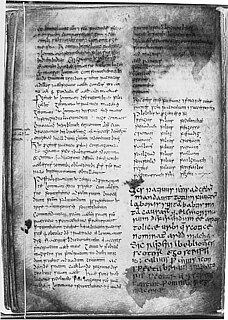 W
WThe Book of Armagh or Codex Ardmachanus, also known as the Canon of Patrick and the Liber Ar(d)machanus, is a 9th-century Irish illuminated manuscript written mainly in Latin. It is held by the Library of Trinity College Dublin. The document is valuable for containing early texts relating to St Patrick and some of the oldest surviving specimens of Old Irish, and for being one of the earliest manuscripts produced by an insular church to contain a near complete copy of the New Testament.
 W
WThe Book of Cerne is an early ninth-century Insular or Anglo-Saxon Latin personal prayer book with Old English components. It belongs to a group of four such early prayer books, the others being the Royal Prayerbook, the Harleian prayerbook, and the Book of Nunnaminster. It is now commonly believed to have been produced sometime between ca. 820 and 840 CE in the Southumbrian/Mercian region of England. The original book contains a collection of several different texts, including New Testament Gospel excerpts, a selection of prayers and hymns with a version of the Lorica of Laidcenn, an abbreviated or Breviate Psalter, and a text of the Harrowing of Hell liturgical drama, which were combined together to provide a source used for private devotion and contemplation. Based on stylistic and palaeographical features, the Book of Cerne has been included within the Canterbury or Tiberius group of manuscripts that were manufactured in southern England in the 8th and 9th centuries CE associated with the Mercian hegemony in Anglo-Saxon England. This Anglo-Saxon manuscript is considered to be the most sophisticated and elaborate of this group. The Book of Cerne exhibits various Irish/Celtic, Anglo-Saxon, Continental, and Mediterranean influences in its texts, ornamentation, and embellishment.
 W
WThe Book of Deer is a 10th-century Latin Gospel Book with early 12th-century additions in Latin, Old Irish and Scottish Gaelic. It is noted for containing the earliest surviving Gaelic writing from Scotland.
 W
WThe Book of Dimma is an 8th-century Irish pocket Gospel Book originally from the Abbey of Roscrea, founded by St. Cronan in County Tipperary, Ireland. In addition to the four Gospels, in between the Gospels of Luke and John, it has an order for the Unction and Communion of the Sick. The surviving illumination of the manuscript is a number of illuminated initials, three Evangelist portrait pages, and one page with an Evangelist's symbol. The pocket gospel book is a distinctively Insular format, of which the Book of Mulling is another leading example.
 W
WThe Book of Durrow is a medieval illuminated manuscript gospel book in the Insular script style. It was probably created between 650 and 700. The place of creation may perhaps have been Durrow Abbey in Ireland or a monastery in Northumbria in northeastern England or perhaps Iona Abbey in western Scotland—the place of origin has been debated by historians for decades without a consensus emerging. The Book of Durrow was probably at Durrow Abbey by 916. Today it is in the Library of Trinity College Dublin.
 W
WThe Book of Kells is an illuminated manuscript Gospel book in Latin, containing the four Gospels of the New Testament together with various prefatory texts and tables. It was created in a Columban monastery in either Britain or Ireland and may have had contributions from various Columban institutions from both Britain and Ireland. It is believed to have been created c. 800 AD. The text of the Gospels is largely drawn from the Vulgate, although it also includes several passages drawn from the earlier versions of the Bible known as the Vetus Latina. It is a masterwork of Western calligraphy and represents the pinnacle of Insular illumination. It is also widely regarded as one of Ireland's finest national treasures. The manuscript takes its name from the Abbey of Kells, which was its home for centuries.
 W
WThe Book of Mulling or less commonly, Book of Moling, is an Irish pocket Gospel Book from the late 8th century. The text collection includes the four Gospels, a liturgical service which includes the "Apostles' Creed", and in the colophon, a supposed plan of St. Moling's monastery enclosed by two concentric circles.
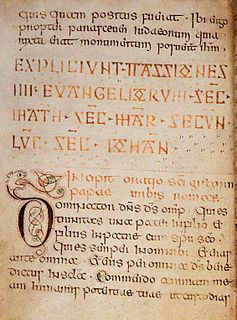 W
WThe Book of Nunnaminster is a 9th-century Anglo-Saxon prayerbook. It was written in the kingdom of Mercia, using an "insular" hand, related to Carolingian minuscule. It was probably later owned by Ealhswith, wife of Alfred the Great. It is related to, but of an earlier date than, the Book of Cerne, and also to the Royal Prayerbook and the Harleian prayerbook. Like Cerne it contains the Passion narratives of the four Gospels and a collection of non-liturgical prayers, many of which relate to the Passion. The Book of Nunnaminster shares some poems with the Book of Cerne. The Book of Nunnaminster includes some decorated initials.
 W
WBritish Library, Egerton MS 609 is a Breton Gospel Book from the late or third quarter of the ninth century. It was created in France, though the exact location is unknown. The large decorative letters which form the beginning of each Gospel are similar to the letters found in Carolingian manuscripts, but the decoration of these letters is closer to that found in insular manuscripts, such as the Book of Kells and the Lindisfarne Gospels. However, the decoration in the Breton Gospel Book is simpler and more geometric in form than that found in the Insular manuscripts. The manuscript contains the Latin text of St Jerome's letter to Pope Damasus, St. Jerome's commentary on Matthew, and the four Gospels, along with prefatory material and canon tables. This manuscript is part of the Egerton Collection in the British Library.
 W
WCarpet pages are a characteristic feature of Insular illuminated manuscripts. They are pages of mainly geometrical ornamentation, which may include repeated animal forms, typically placed at the beginning of each of the four Gospels in Gospel Books. The designation "carpet page" is used to describe those pages in Christian, Islamic, or Jewish illuminated manuscripts that contain little or no text and which are filled entirely with decorative motifs. They are distinct from pages devoted to highly decorated historiated initials, though the style of decoration may be very similar.
 W
WThe Cathach of St. Columba is a late 6th century Insular psalter.
 W
WCodex Usserianus Primus is an early 7th-century Old Latin Gospel Book. It is dated palaeographically to the 6th or 7th century. It is designated by r.
 W
WA cumdach or book shrine is an elaborate ornamented box or case used as a reliquary to enshrine books regarded as relics of the saints who had used them in Early Medieval Ireland. They are normally later than the book they contain, often by several centuries, typically the book comes from the heroic age of Irish monasticism before 800, and the surviving cumdachs date from after 1000, although it is clear the form dates from considerably earlier. Several were then considerably reworked in the Gothic period. The usual form is a design based on a cross on the main face, with use of large gems of rock crystal or other semi-precious stones, leaving the spaces between the arms of the cross for more varied decoration. Several were carried on a chain or cord, often suspended round the neck, which by placing them next to the heart was believed to bring spiritual and perhaps medical benefits. They were also used to witness contracts. Many had hereditary lay keepers from among the chiefly families who had formed links with monasteries. Most surviving examples are now in the National Museum of Ireland ("NMI").
 W
WThe Durham Cassidorus is an 8th-century illuminated manuscript containing Cassiodorus's Explanation of the Psalms. The manuscript contains two surviving miniatures of King David, one of David as Victor (right) and one of David as Musician. A third miniature is known to have existed, but does not survive. The manuscript was produced in Northumbria in about 730. The codex has 261 surviving folios. It is the earliest known copy of the commentary written by Cassiodorus in the sixth century and the hands of six scribes have been identified within it.
 W
WThe Durham Gospels is a very incomplete late 7th century insular Gospel Book, now kept in the Durham Cathedral Dean and Chapter Library. A single folio of this manuscript is now in Magdalene College, Cambridge. Only two of the fully decorated pages survive: a Crucifixion and the initial to John, and both of these are in poor condition. There were probably originally evangelist portraits and carpet pages, as in other Insular Gospel books conceived on a similar scale. The book was produced at Lindisfarne and brought to Durham when the monks of Lindisfarne removed to Durham because of Viking attacks. The Durham Gospels were written by the same scribe that wrote the Echternach Gospels.
 W
WThe Echternach Gospels were produced, presumably, at Lindisfarne Abbey in Northumbria around the year 690. This location was very significant for the production of Insular manuscripts, such as the Durham Gospels and the Lindisfarne Gospels. The scribe of the Durham Gospels is believed to have created the Echternach Gospels as well. The Echternach Gospels are now in the collection of France’s Bibliothèque Nationale in Paris.
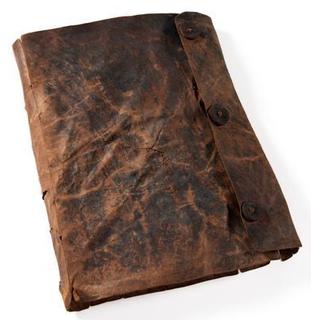 W
WThe Faddan More Psalter is an early medieval Christian psalter or text of the book of Psalms, discovered in a peat bog in July 2006, in the townland of Faddan More in north County Tipperary, Ireland. The manuscript was probably written in about 800 CE in one of a number of monasteries in the area. A unique feature is that the inside of the leather cover is lined with papyrus, probably as a stiffening, an indication of the links between the Irish and Coptic churches at the time. After several years of conservation work, the psalter went on display at the National Museum of Ireland in Kildare St, Dublin in June 2011.
 W
WBritish Library, Add MS 40618 is a late 8th century illuminated Irish Gospel Book with 10th century Anglo-Saxon additions. The manuscript contains a portion of the Gospel of Matthew, the majority of the Gospel of Mark and the entirety of the Gospels of Luke and John. There are three surviving Evangelist portraits, one original and two 10th century replacements, along with 10th century decorated initials. It is catalogued as number 40618 in the Additional manuscripts collection at the British Library.
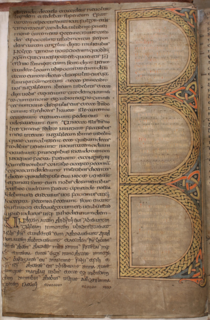 W
WDurham Cathedral Library, Manuscript A.II.10. is a fragmentary seventh century Insular Gospel Book, produced in Lindisfarne c. 650. Only seven leaves of the book survive, bound in three separate volumes in the Durham Cathedral Dean and Chapter Library. Although this book is fragmentary, it is the earliest surviving example in the series of lavish Insular Gospel Books which includes the Book of Durrow, the Lindisfarne Gospels, the St. Teilo Gospels and the Book of Kells.
 W
WThe Hereford Gospels is an 8th-century illuminated manuscript gospel book in insular script (minuscule), with large illuminated initials in the Insular style. This is a very late Anglo-Saxon gospel book, which shares a distinctive style with the Caligula Troper. An added text suggests this was in the diocese of Hereford in the 11th century.
 W
WInsular art, also known as Hiberno-Saxon art, was produced in the post-Roman history of Ireland and Britain. The term derives from insula, the Latin term for "island"; in this period Britain and Ireland shared a largely common style different from that of the rest of Europe. Art historians usually group insular art as part of the Migration Period art movement as well as Early Medieval Western art, and it is the combination of these two traditions that gives the style its special character.
 W
WThe Ismere Diploma is a charter of 736, in which Aethelbald of Mercia grants ten hides of land near Ismere to Cyneberht, his "venerable companion", for the foundation of a coenubium (minster).
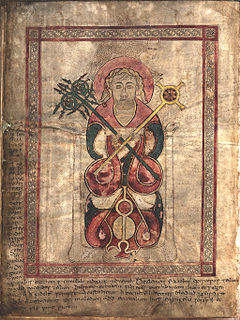 W
WThe Lichfield Gospels is an 8th century Insular Gospel Book housed in Lichfield Cathedral. There are 236 surviving pages, eight of which are illuminated. Another four contain framed text. The pages measure 30.8 cm by 23.5 cm. The manuscript is also important because it includes, as marginalia, some of the earliest known examples of written Old Welsh, dating to the early part of the 8th century. Peter Lord dates the book at 730, placing it chronologically before the Book of Kells but after the Lindisfarne Gospels.
 W
WThe Lindisfarne Gospels is an illuminated manuscript gospel book probably produced around the years 715-720 in the monastery at Lindisfarne, off the coast of Northumberland, which is now in the British Library in London. The manuscript is one of the finest works in the unique style of Hiberno-Saxon or Insular art, combining Mediterranean, Anglo-Saxon and Celtic elements.
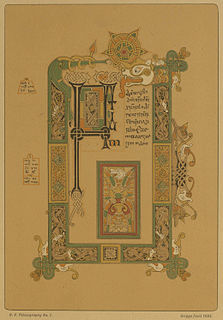 W
WThe Mac Durnan Gospels or Book of Mac Durnan is an early medieval Irish illuminated manuscript containing the four Gospels, now in the collection of the Lambeth Palace Library in London.
 W
WThe Otho-Corpus Gospels is a badly damaged and fragmentary 8th century illuminated manuscript. It was part of the Cotton library and was mostly burnt in the 1731 fire at Ashburnham House. The manuscript now survives as charred fragments in the British Library. Thirty six pages of the manuscript were not in the Cotton collection and survived the fire. They are now in the library of Corpus Christi College, Cambridge.
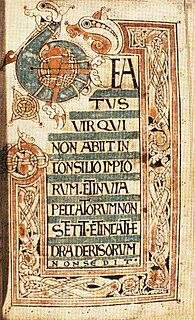 W
WThe Ricemarch Psalter is an 11th-century Welsh illuminated psalter, in a late Insular style, that has been described as "Hiberno-Danish", instead of the usual "Hiberno-Saxon", as it reflects Viking influence. Its 159 pages are vellum, and include the following sections: Letter of St. Jerome to Chromatius and Elidorus; Breviarius Apostolorum; Martyrologium Hieronymianum, and Various Tables. It is one of two surviving manuscripts from the scriptorium at Llanbadarn Fawr in Wales, established by the father of the scribe and the first owner. The other is a manuscript of St. Augustine's De Trinitate in Cambridge, by the same scribe. The psalter is now at Trinity College Dublin as MS 50.
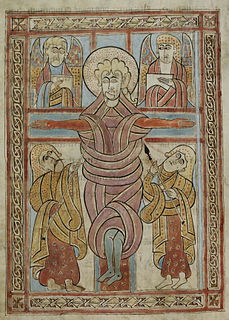 W
WThe Irish Gospels of St. Gall or Codex Sangallensis 51 is an 8th-century Insular Gospel Book, written either in Ireland or by Irish monks in the Abbey of St. Gall in Switzerland, where it is now in the Abbey library of St. Gallen as MS 51. It has 134 folios. Amongst its 11 illustrated pages are a Crucifixion, a Last Judgement, a Chi Rho monogram page, a carpet page, and Evangelist portraits.
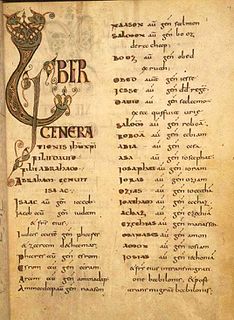 W
WThe Schuttern Gospels is an early 9th century illuminated Gospel Book that was produced at Schuttern Abbey in Baden. According to a colophon on folio 206v, the manuscript was written by the deacon Liutharius, at the order of his abbot, Bertricus.
 W
WThe Southampton Psalter is an Insular illuminated Psalter from Ireland. It is asserted by some to be from ninth-century in date, while other scholars have argued for a tenth- or even early eleventh-century dating. It has illuminations including three full page miniatures and also contains numerous annotations in both Latin and Old Irish.
 W
WThe St Cuthbert Gospel, also known as the Stonyhurst Gospel or the St Cuthbert Gospel of St John, is an early 8th-century pocket gospel book, written in Latin. Its finely decorated leather binding is the earliest known Western bookbinding to survive, and both the 94 vellum folios and the binding are in outstanding condition for a book of this age. With a page size of only 138 by 92 millimetres, the St Cuthbert Gospel is one of the smallest surviving Anglo-Saxon manuscripts. The essentially undecorated text is the Gospel of John in Latin, written in a script that has been regarded as a model of elegant simplicity.
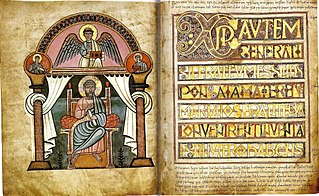 W
WThe Stockholm Codex Aureus is a Gospel book written in the mid-eighth century in Southumbria, probably in Canterbury, whose decoration combines Insular and Italian elements. Southumbria produced a number of important illuminated manuscripts during the eighth and early ninth centuries, including the Vespasian Psalter, the Stockholm Codex Aureus, three Mercian prayer books, the Tiberius Bede and the British Library's Royal Bible.
 W
WThe Stowe Missal, which is, strictly speaking, a sacramentary rather than a missal, is an Irish illuminated manuscript written mainly in Latin with some Old Irish in the late eighth or early ninth century, probably after 792. In the mid-11th century it was annotated and some pages rewritten at Lorrha Monastery in County Tipperary, Ireland. Also known as the Lorrha Missal, it is known as the "Stowe" Missal as it once belonged to the Stowe manuscripts collection formed by George Nugent-Temple-Grenville, 1st Marquess of Buckingham at Stowe House. When the collection was bought by the nation in 1883, it and the other Irish manuscripts were handed over to the Royal Irish Academy in Dublin, where it remains, catalogued as MS D II 3. The cumdach or reliquary case which up to this point had survived together with the book was later transferred, with the rest of the Academy's collection of antiquities, to the National Museum of Ireland. The old story was that the manuscript and shrine left Ireland after about 1375, as they were collected on the Continent in the 18th century, but this appears to be incorrect, and they were found inside a stone wall at Lackeen Castle near Lorrha in the 18th century.
 W
WThe Vespasian Psalter is an Anglo-Saxon illuminated psalter decorated in a partly Insular style produced in the second or third quarter of the 8th century. It contains an interlinear gloss in Old English which is the oldest extant English translation of any portion of the Bible. It was produced in southern England, perhaps in St. Augustine's Abbey or Christ Church, Canterbury or Minster-in-Thanet, and is the earliest illuminated manuscript produced in "Southumbria" to survive.